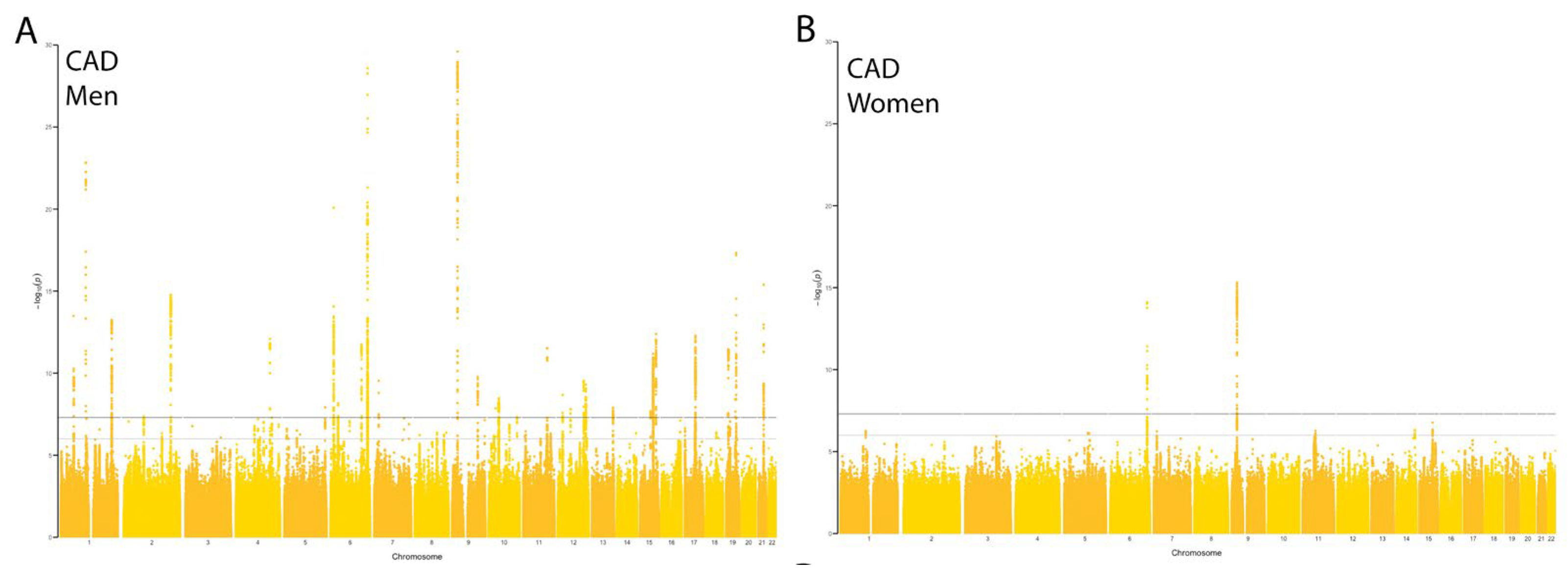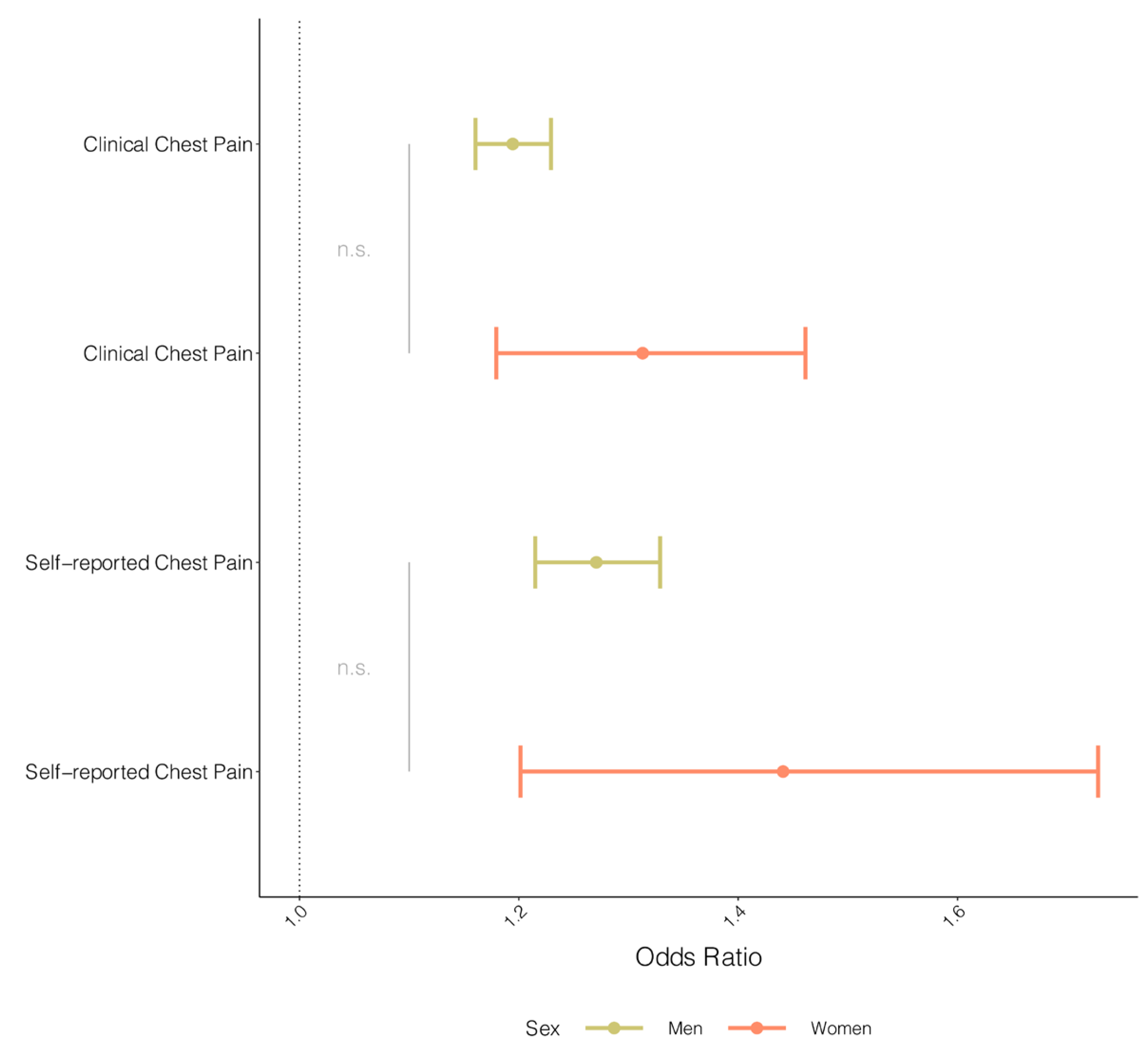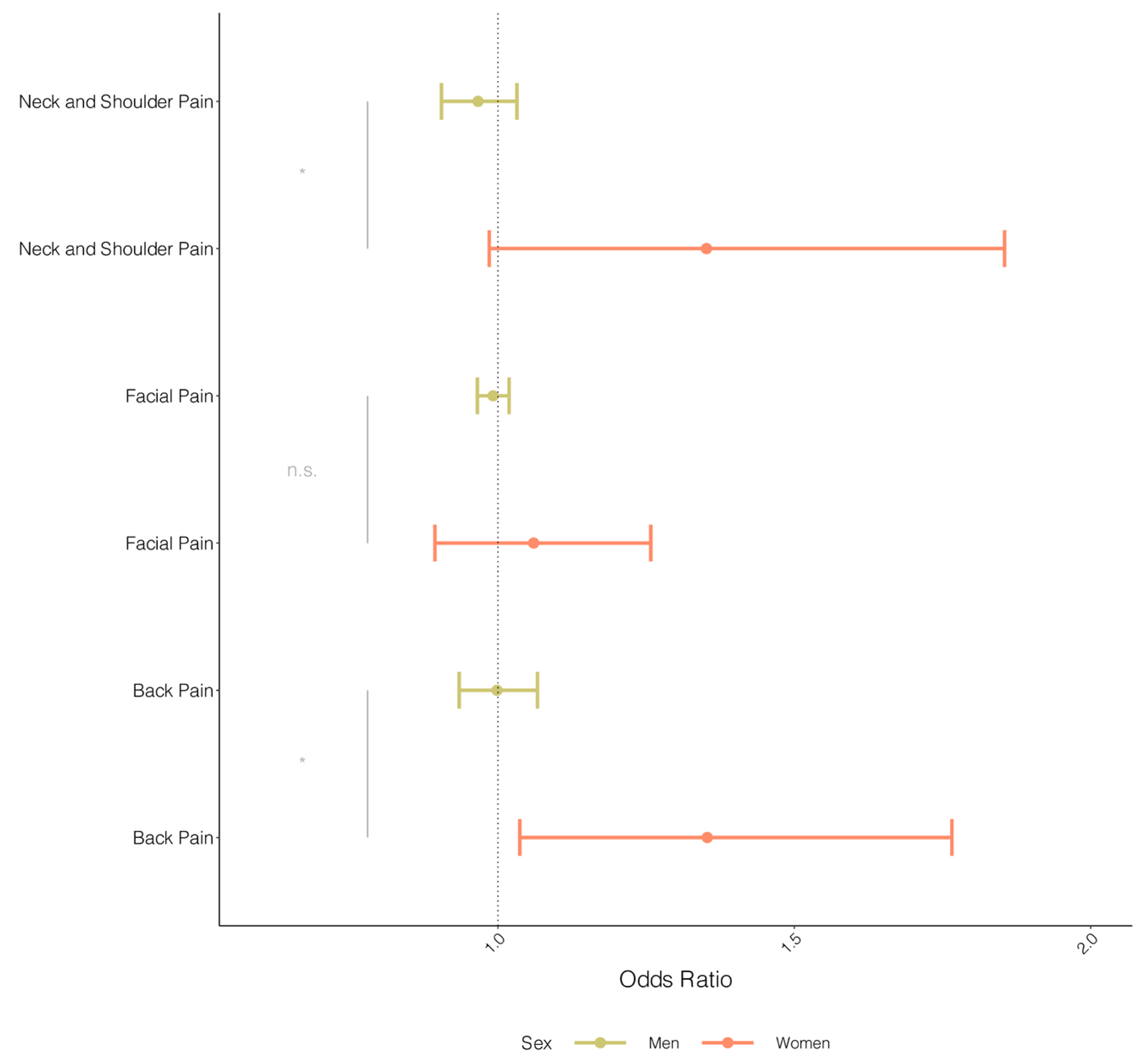Exploring Sex Differences in Pain Manifestation of Coronary Artery Disease through Mendelian Randomization
Abstract
1. Introduction
2. Materials and Methods
2.1. Study Design and Study Population
2.2. Ascertainment of Exposure and Outcome Variables
2.3. Sex-Stratified Genome-Wide Association Analysis
2.4. Mendelian Randomization Analyses
3. Results
3.1. Sex-Stratified GWAS Reveals Genome-Wide Significant Variants for CAD
3.2. Mendelian Randomization Provides Evidence Favoring a Causal Effect between CAD and Chest Pain in Men and Women
3.3. Assessment of Sex-Specific Pain Localization of Coronary Artery Disease
4. Discussion
5. Conclusions
Supplementary Materials
Author Contributions
Funding
Institutional Review Board Statement
Informed Consent Statement
Data Availability Statement
Acknowledgments
Conflicts of Interest
References
- World Health Organization. Global Action Plan for the Prevention and Control of Noncommunicable Diseases: 2013–2020; World Health Organization: Geneva, Switzerland, 2013. [Google Scholar]
- Bergami, M.; Scarpone, M.; Bugiardini, R.; Cenko, E.; Manfrini, O. Sex beyond cardiovascular risk factors and clinical biomarkers of cardiovascular disease. Rev. Cardiovasc. Med. 2022, 23, 19. [Google Scholar] [CrossRef]
- Roeters van Lennep, J.E.; Tokgözoğlu, L.S.; Badimon, L.; Dumanski, S.M.; Gulati, M.; Hess, C.N.; Holven, K.B.; Kavousi, M.; Kayıkçıoğlu, M.; Lutgens, E.; et al. Women, lipids, and atherosclerotic cardiovascular disease: A call to action from the European Atherosclerosis Society. Eur. Heart J. 2023, 44, ehad472. [Google Scholar] [CrossRef]
- Knuuti, J.; Wijns, W.; Saraste, A.; Capodanno, D.; Barbato, E.; Funck-Brentano, C.; Prescott, E.; Storey, R.F.; Deaton, C.; Cuisset, T.; et al. 2019 ESC Guidelines for the diagnosis and management of chronic coronary syndromes. Eur. Heart J. 2020, 41, 407–477. [Google Scholar] [CrossRef]
- Eaker, E.D.; Chesebro, J.H.; Sacks, F.M.; Wenger, N.K.; Whisnant, J.P.; Winston, M. Cardiovascular disease in women. Circulation 1993, 88, 1999–2009. [Google Scholar] [CrossRef]
- Løvlien, M.; Schei, B.; Hole, T. Women with myocardial infarction are less likely than men to experience chest symptoms. Scand. Cardiovasc. J. 2006, 40, 342–347. [Google Scholar] [CrossRef]
- Garcia, M.; Mulvagh, S.L.; Bairey Merz, C.N.; Buring, J.E.; Manson, J.E. Cardiovascular Disease in Women: Clinical Perspectives. Circ. Res. 2016, 118, 1273–1293. [Google Scholar] [CrossRef]
- Culić, V.; Eterović, D.; Mirić, D.; Silić, N. Symptom presentation of acute myocardial infarction: Influence of sex, age, and risk factors. Am. Heart J. 2002, 144, 1012–1017. [Google Scholar] [CrossRef]
- Canto, J.G.; Rogers, W.J.; Goldberg, R.J.; Peterson, E.D.; Wenger, N.K.; Vaccarino, V.; Kiefe, C.I.; Frederick, P.D.; Sopko, G.; Zheng, Z.J. Association of age and sex with myocardial infarction symptom presentation and in-hospital mortality. JAMA 2012, 307, 813–822. [Google Scholar] [CrossRef]
- Kreatsoulas, C.; Shannon, H.S.; Giacomini, M.; Velianou, J.L.; Anand, S.S. Reconstructing angina: Cardiac symptoms are the same in women and men. JAMA Intern. Med. 2013, 173, 829–831. [Google Scholar] [CrossRef][Green Version]
- Mackay, M.H.; Ratner, P.A.; Johnson, J.L.; Humphries, K.H.; Buller, C.E. Gender differences in symptoms of myocardial ischaemia. Eur. Heart J. 2011, 32, 3107–3114. [Google Scholar] [CrossRef]
- Milner, K.A.; Funk, M.; Richards, S.; Wilmes, R.M.; Vaccarino, V.; Krumholz, H.M. Gender differences in symptom presentation associated with coronary heart disease. Am. J. Cardiol. 1999, 84, 396–399. [Google Scholar] [CrossRef]
- Davey Smith, G.; Hemani, G. Mendelian randomization: Genetic anchors for causal inference in epidemiological studies. Hum. Mol. Genet. 2014, 23, R89–R98. [Google Scholar] [CrossRef]
- Davey Smith, G.; Ebrahim, S. ‘Mendelian randomization’: Can genetic epidemiology contribute to understanding environmental determinants of disease? Int. J. Epidemiol. 2003, 32, 1–22. [Google Scholar] [CrossRef]
- Ciofani, J.L.; Han, D.; Allahwala, U.K.; Woolf, B.; Gill, D.; Bhindi, R. Lipids, Blood Pressure, and Diabetes Mellitus on Risk of Cardiovascular Diseases in East Asians: A Mendelian Randomization Study. Am. J. Cardiol. 2023, 205, 329–337. [Google Scholar] [CrossRef]
- Jansen, H.; Samani, N.J.; Schunkert, H. Mendelian randomization studies in coronary artery disease. Eur. Heart J. 2014, 35, 1917–1924. [Google Scholar] [CrossRef]
- Sudlow, C.; Gallacher, J.; Allen, N.; Beral, V.; Burton, P.; Danesh, J.; Downey, P.; Elliott, P.; Green, J.; Landray, M.; et al. UK biobank: An open access resource for identifying the causes of a wide range of complex diseases of middle and old age. PLoS Med. 2015, 12, e1001779. [Google Scholar] [CrossRef]
- Burgess, S.; Labrecque, J.A. Mendelian randomization with a binary exposure variable: Interpretation and presentation of causal estimates. Eur. J. Epidemiol. 2018, 33, 947–952. [Google Scholar] [CrossRef]
- Loh, P.-R.; Tucker, G.; Bulik-Sullivan, B.K.; Vilhjálmsson, B.J.; Finucane, H.K.; Salem, R.M.; Chasman, D.I.; Ridker, P.M.; Neale, B.M.; Berger, B.; et al. Efficient Bayesian mixed-model analysis increases association power in large cohorts. Nat. Genet. 2015, 47, 284–290. [Google Scholar] [CrossRef]
- Neph, S.; Kuehn, M.S.; Reynolds, A.P.; Haugen, E.; Thurman, R.E.; Johnson, A.K.; Rynes, E.; Maurano, M.T.; Vierstra, J.; Thomas, S.; et al. BEDOPS: High-performance genomic feature operations. Bioinformatics 2012, 28, 1919–1920. [Google Scholar] [CrossRef]
- Frankish, A.; Diekhans, M.; Jungreis, I.; Lagarde, J.; Loveland, J.E.; Mudge, J.M.; Sisu, C.; Wright, J.C.; Armstrong, J.; Barnes, I.; et al. GENCODE 2021. Nucleic Acids Res. 2021, 49, D916–D923. [Google Scholar] [CrossRef]
- Hemani, G.; Zheng, J.; Elsworth, B.; Wade, K.H.; Haberland, V.; Baird, D.; Laurin, C.; Burgess, S.; Bowden, J.; Langdon, R.; et al. The MR-Base platform supports systematic causal inference across the human phenome. eLife 2018, 7, e34408. [Google Scholar] [CrossRef]
- Pierce, B.L.; Ahsan, H.; Vanderweele, T.J. Power and instrument strength requirements for Mendelian randomization studies using multiple genetic variants. Int. J. Epidemiol. 2011, 40, 740–752. [Google Scholar] [CrossRef]
- Verbanck, M.; Chen, C.Y.; Neale, B.; Do, R. Detection of widespread horizontal pleiotropy in causal relationships inferred from Mendelian randomization between complex traits and diseases. Nat. Genet. 2018, 50, 693–698. [Google Scholar] [CrossRef]
- Hemani, G.; Tilling, K.; Davey Smith, G. Orienting the causal relationship between imprecisely measured traits using GWAS summary data. PLoS Genet. 2017, 13, e1007081. [Google Scholar] [CrossRef]
- Mounier, N.; Kutalik, Z. Correction for sample overlap, winner’s curse and weak instrument bias in two-sample Mendelian Randomization. bioRxiv 2021. [Google Scholar] [CrossRef]
- Altman, D.G.; Bland, J.M. Interaction revisited: The difference between two estimates. BMJ 2003, 326, 219. [Google Scholar] [CrossRef]
- Brion, M.-J.A.; Shakhbazov, K.; Visscher, P.M. Calculating statistical power in Mendelian randomization studies. Int. J. Epidemiol. 2013, 42, 1497–1501. [Google Scholar] [CrossRef]
- Johnston, K.J.A.; Ward, J.; Ray, P.R.; Adams, M.J.; McIntosh, A.M.; Smith, B.H.; Strawbridge, R.J.; Price, T.J.; Smith, D.J.; Nicholl, B.I.; et al. Sex-stratified genome-wide association study of multisite chronic pain in UK Biobank. PLoS Genet. 2021, 17, e1009428. [Google Scholar] [CrossRef]
- Vaccarino, V.; Badimon, L.; Corti, R.; de Wit, C.; Dorobantu, M.; Manfrini, O.; Koller, A.; Pries, A.; Cenko, E.; Bugiardini, R. Presentation, management, and outcomes of ischaemic heart disease in women. Nat. Rev. Cardiol. 2013, 10, 508–518. [Google Scholar] [CrossRef]
- Bugiardini, R. Women, ‘non-specific’ chest pain, and normal or near-normal coronary angiograms are not synonymous with favourable outcome. Eur. Heart J. 2006, 27, 1387–1389. [Google Scholar] [CrossRef]
- Everts, B.; Karlson, B.W.; Währborg, P.; Hedner, T.; Herlitz, J. Localization of pain in suspected acute myocardial infarction in relation to final diagnosis, age and sex, and site and type of infarction. Heart Lung 1996, 25, 430–437. [Google Scholar] [CrossRef]
- Kreiner, M.; Alvarez, R.; Waldenström, A.; Michelis, V.; Muñiz, R.; Isberg, A. Craniofacial pain of cardiac origin is associated with inferior wall ischemia. J. Oral Facial Pain Headache 2014, 28, 317–321. [Google Scholar] [CrossRef] [PubMed]
- Baker, D.G.; Coleridge, H.M.; Coleridge, J.C.; Nerdrum, T. Search for a cardiac nociceptor: Stimulation by bradykinin of sympathetic afferent nerve endings in the heart of the cat. J. Physiol. 1980, 306, 519–536. [Google Scholar] [CrossRef]
- Foreman, R.D.; Garrett, K.M.; Blair, R.W. Mechanisms of Cardiac Pain. In Comprehensive Physiology, 1st ed.; Terjung, R., Ed.; Wiley: Hoboken, NJ, USA, 2015; pp. 929–960. [Google Scholar]
- Cervero, F. Somatic and visceral inputs to the thoracic spinal cord of the cat: Effects of noxious stimulation of the biliary system. J. Physiol. 1983, 337, 51–67. [Google Scholar] [CrossRef]
- Cervero, F.; Laird, J.M.A. Visceral pain. Lancet 1999, 353, 2145–2148. [Google Scholar] [CrossRef]
- Erhardt, L.; Herlitz, J.; Bossaert, L.; Halinen, M.; Keltai, M.; Koster, R.; Marcassa, C.; Quinn, T.; van Weert, H. Task Force on the management of chest, p. Task force on the management of chest pain. Eur. Heart J. 2002, 23, 1153–1176. [Google Scholar] [CrossRef]
- Lamberts, H.; Brouwer, H.J.; Mohrs, J. Reason for Encounter-, Episode- and Process-Oriented Standard Output: From the Transition Project; Department of General Practice/Family Medicine, University of Amsterdam: Amsterdam, The Netherlands, 1991. [Google Scholar]
- Herlitz, J.; Bång, A.; Isaksson, L.; Karlsson, T. Outcome for patients who call for an ambulance for chest pain in relation to the dispatcher’s initial suspicion of acute myocardial infarction. Eur. J. Emerg. Med. Off. J. Eur. Soc. Emerg. Med. 1995, 2, 75–82. [Google Scholar] [CrossRef]
- Chen, Z.; Schunkert, H. Genetics of coronary artery disease in the post-GWAS era. J. Intern. Med. 2021, 290, 980–992. [Google Scholar] [CrossRef]
- Zhu, J.; Wang, N.; Liu, H.; Jiang, H.; Cai, B.; Chen, D.; Li, Y. Multisite chronic pain as a causal risk factor for coronary artery disease: Findings from Mendelian randomization. Pain 2023, 164, e135–e143. [Google Scholar] [CrossRef]



Disclaimer/Publisher’s Note: The statements, opinions and data contained in all publications are solely those of the individual author(s) and contributor(s) and not of MDPI and/or the editor(s). MDPI and/or the editor(s) disclaim responsibility for any injury to people or property resulting from any ideas, methods, instructions or products referred to in the content. |
© 2024 by the authors. Licensee MDPI, Basel, Switzerland. This article is an open access article distributed under the terms and conditions of the Creative Commons Attribution (CC BY) license (https://creativecommons.org/licenses/by/4.0/).
Share and Cite
Methorst, R.; Jongbloed, M.R.M.; Noordam, R.; DeRuiter, M.C. Exploring Sex Differences in Pain Manifestation of Coronary Artery Disease through Mendelian Randomization. J. Cardiovasc. Dev. Dis. 2024, 11, 264. https://doi.org/10.3390/jcdd11090264
Methorst R, Jongbloed MRM, Noordam R, DeRuiter MC. Exploring Sex Differences in Pain Manifestation of Coronary Artery Disease through Mendelian Randomization. Journal of Cardiovascular Development and Disease. 2024; 11(9):264. https://doi.org/10.3390/jcdd11090264
Chicago/Turabian StyleMethorst, Ruben, Monique R. M. Jongbloed, Raymond Noordam, and Marco C. DeRuiter. 2024. "Exploring Sex Differences in Pain Manifestation of Coronary Artery Disease through Mendelian Randomization" Journal of Cardiovascular Development and Disease 11, no. 9: 264. https://doi.org/10.3390/jcdd11090264
APA StyleMethorst, R., Jongbloed, M. R. M., Noordam, R., & DeRuiter, M. C. (2024). Exploring Sex Differences in Pain Manifestation of Coronary Artery Disease through Mendelian Randomization. Journal of Cardiovascular Development and Disease, 11(9), 264. https://doi.org/10.3390/jcdd11090264







